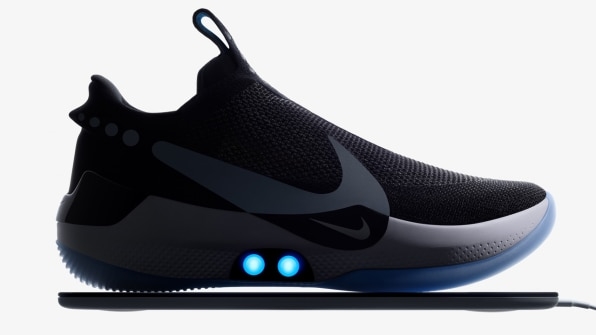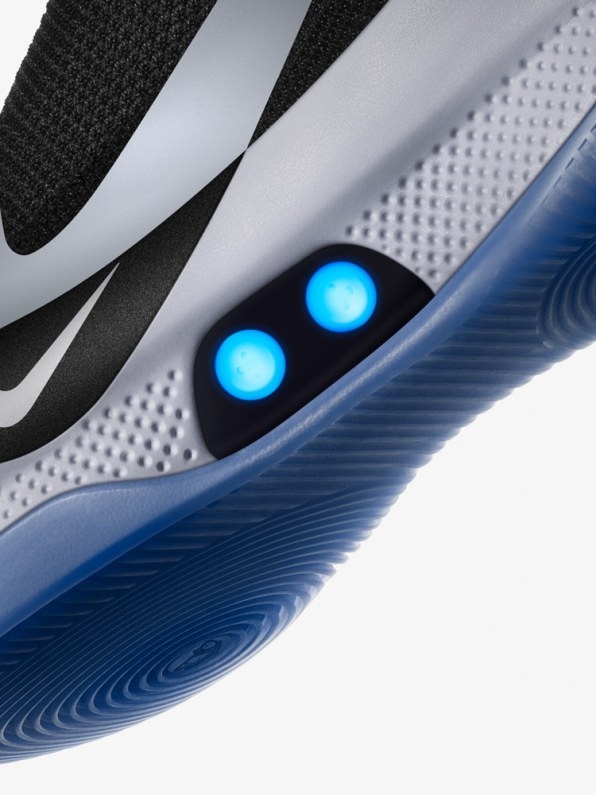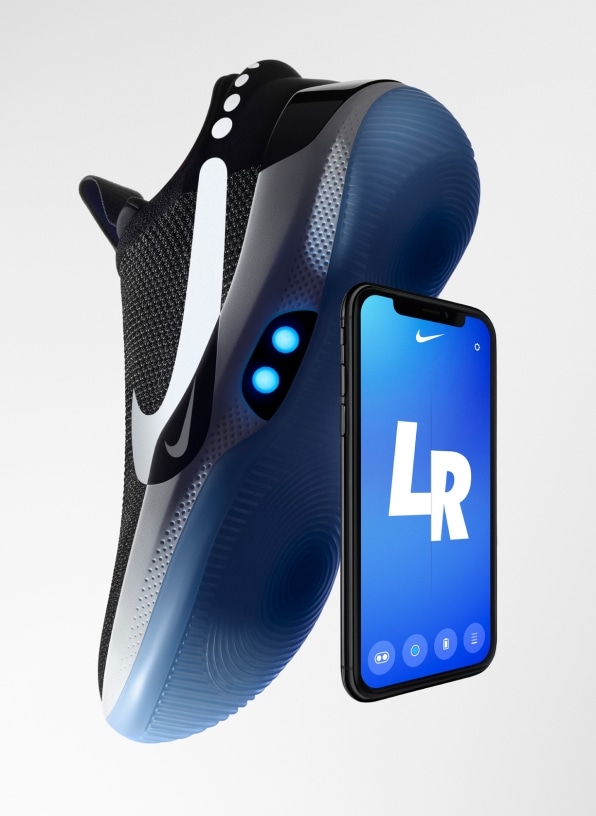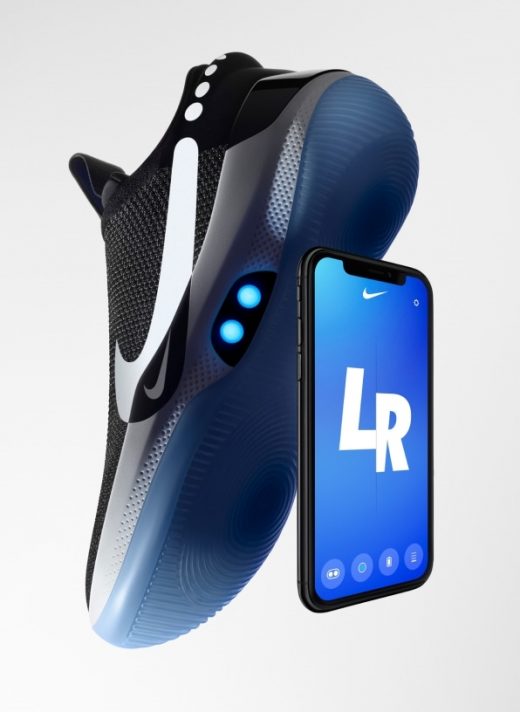Nike’s big bet on the future of connected shoes
For the past three years, a team inside Nike has been working on a shoe that could change the trajectory of the company. It’s the most-tested piece of footwear Nike has ever released. Athletes, ranging from high schoolers to pros, wore it for more than 27,000 miles on the court. Laces were snapped. Circuits were crushed underfoot. In the end, Nike developed a final product it calls Nike Adapt BB (the “BB” stands for “basketball”).
At a glance, it’s a high-tech, low-top basketball shoe with self-tightening Power Laces. It’s the first time the legendary shoe designer Tinker Hatfield’s 30-year-old vision from Back to the Future II has come to life–at least in the form of a shoe that Nike is willing to deem a performance-level product (the company released a pair of self-lacing shoes back in 2016).
But more importantly, it’s the first digitally connected shoe that doesn’t just measure your activity the way Nike+ technologies have for years. Instead, the Adapt BB can actively alter its shape, adapting in ways that fixed foams and Flyknits never could, whether that’s locking on tight to your foot during a drive to the hoop, or just loosening your kicks into slipper mode after a long day at the office.
“We’re moving from a fixed state of performance to something more fluid and dynamic,” says Eric Avar, creative director of innovation at Nike, who was the 15th designer Nike hired 27 years ago. “As long as I’ve been here at Nike, this has been a conversation, and I think we’re just starting to see it come to fruition.”
The Nike Adapt BB debuts technology that Nike executives readily put on the same pedestal as Nike Air. But for Nike, the Adapt BB is just the first step on a long journey toward making shoes that can literally feel your pain and react to it–the sort of shapeshifting apparel teased by researchers for years. It’s just the sort of radical product that proves that Nike, despite being the number-one shoe manufacturer in the world, sitting on a few years of solid growth and a strong appetite from China, doesn’t want to leave room for competitors to catch up.
The Adapt BB will be available on February 17 for $350, but the public can expect countless additional updates to the Nike Adapt platform–mix of sensors, processors, and digital software–which will eventually be applied to other products to tackle problems beyond just fit. In fact, Adapt technology is expected to come to other Nike shoes and clothing in the months and years to come. The company’s apparel will soon tailor itself to you, at a moment’s notice.

The Shoe
The Nike Adapt BB is an unabashed tech product, complete with two glowing LED circles in the sole that are meant to anthropomorphize the shoe with eyes, suggesting that the footwear is alive, if only a little. The shoes connect to your smartphone of choice via Bluetooth–you can even use your phone to change the color of the LED lights. To keep the shoes powered, the soles rest on an inductive charger, which tops off their batteries to run about 10 days on a charge.
To skeptics, these tropes might make a bad first impression. Charging! Lights! Smart shoes have failed to catch fire over the past few years–including Nike’s own launch of Nike+ basketball shoes in 2012.

But Nike’s meticulous attention to classic shoe design can’t be denied. The outer shell of the shoe fits like a sock, woven from Nike’s yarn-like Flyknit fabric. Inside that layer is basically a whole other shoe, woven from Nike’s firmer, newer Quadfit material, complete with a more typical tongue. This double-stacked mix of materials and construction is the result of multiple fit studies performed within Nike to help make all the new tech in the shoe feel both comfortable and familiar.
Ask anyone at Nike why they launched Adapt technologies with a basketball shoe, and they’ll tell you it’s because basketball is the most challenging vertical–a combination of big jumps, hard landings, and lateral cuts that are more explosive and less predictable than any other sport. Question why they started the Adapt platform with a self-tightening “lace engine,” and they’ll explain it’s because fit is the most important quality of any shoe.
Case in point: LeBron James takes 10 minutes to lace up his shoes before a game to get that perfect level of “containment,” according to Nike. Containment is the phenomenon in which the bottom of your foot and the sole of your shoe become a single entity, so that you don’t slip or lose any energy as you move.
The Nike Adapt BB’s primary goal is to automate containment. The shoe doesn’t have laces as you know them. You slip your foot inside, and with a squeeze of buttons hidden in the upper, or a tap of a smartphone app, a series of integrated straps wrapping around your foot will tighten down to your preferred level. Inside the shoe, the lace engine–which is a small gear box that fits into the midsole–features sensors and microprocessors that spool up loose slack with 32 pounds of pressure to tighten the upper without yanking with the tips of your fingers.
Getting the perfect amount of tightness was a challenge, because fit is at least partially subjective–and because you don’t always want shoes to fit the same way.
“If you’re going to have a shoe you wear all day long, generally people don’t want an ultra-tight, form-fitting, no-room-for-breathing experience,” says Michael Donaghu, vice president of innovation at Nike. “But if you’re lining up at the starting line of the 100m final of the Olympic Games, you have your shoe so tightly fit to your body.”
Nike’s solution was twofold. First, the designers built extra foam into the tongue and the heel of the shoe, to create a bit of wiggle room when it comes to locking down without squashing your foot. The second solution was to create “modes” of tightness. When you first set up your shoe–with the aid of an iPhone or Android phone–it gradually tightens to help you find your primary mode. After that, you can set up other modes. So if you’re an athlete, you might want a Bench mode that’s loose, a Warm Up mode that’s medium tight, and a Game mode that’s super locked down. Through the game, you could adjust your fit by tapping at the shoe or your smartphone, rather than re-lacing. Perhaps smartphone-managed presets sound like a headache. But they come with a big advantage: Nike claims the Adapt BB’s Power Laces provide a 40% improvement to containment over their best basketball shoe.
The Platform
The Nike Adapt platform is a lot more than the lace engine. It’s what Nike’s designers and engineers compare to an iPhone that lives under your foot–capable of withstanding someone literally jumping on it again and again–with enough durability to actually outlast the foams and cloths of the shoe itself. The hardware will be constantly iterated upon (the company is already planning second and third versions). And it will collect an unprecedented amount of data about human movement, akin to what Nike collects in its own internal Performance Lab. “Not like GPS,” cautions Donaghu. “Literally the forces you are using.”
For that data, Nike has many plans–first and foremost of which is creating shoes that will adjust to your needs in real time, not just through presets.

“If your feet swell or socks change, we do have the ability to understand that,” says Jordan Rice, senior director and smart systems engineer. “And it’s the world’s first firmware updatable shoe, so there’s plenty of opportunity [to take advantage of it].” From my interviews with Nike, it seemed plausible that the BB will receive such an update.
The other aspect of this data collection could inform how you train or even play. Here’s where the connected smartphone app comes in, providing all sorts of feedback to the user that screen-less shoes can’t.
“If we see you’re running without perfect bilateral balance, we know that now. We can change the way you train to get stronger, maybe head off injury,” says Donaghu. “Another thing we have is this unbelievable partnership of teammates and elite athletes in every sport. It has been difficult to share how Michael Jordan moves, deeply. How do we bring what an athlete knows and does [to you]?”
I float the possibility of a “Couch to Dunk” mode, much like the famous “Couch to 5K” running plan–a set regimen anyone could follow to learn how to dunk. Donaghu confirms this is just the sort of thing they’d like to bring consumers, to create a more long-tail relationship after a shoe is purchased.
This digital-tracking relationship may worry some privacy-minded athletes. Nike claims that sharing your data with the company will always be completely opt-in on the Adapt platform. Nike Adapt BB’s fit will be customizable “forever” without “making you opt-in to anything,” according to Donaghu. And Adapt’s services will be tiered, allowing you to use some features by sharing some, but not all of your data. Furthermore, Nike promises to never share your data with third parties–though of course that promise alone can’t stop a data breach.
If you squint through all the design and technology, you can spot a deeper business plan at play. It’s easy to imagine Nike using Adapt to diversify its revenue from products into services. While Nike does not break out revenue from services in public accounting, it’s hard to imagine the brand is making much, if anything, from its now-free Nike+ subscriptions. Even companies like Apple are eyeing services because, sooner or later, it just gets hard to sell more things. While Nike representatives tell me they have no immediate plans to create revenue from the Adapt digital product, it’s easy to imagine future opportunities including subscriptions and one-off workout plans, if it scales.
But to pigeonhole Nike Adapt as some subscription-based revenue generator misses out on what the product means to veteran designers working within Nike–and what it could mean for the future of apparel.
“We believe a big portion of the future of performance will be adaptive . . . It might be electro-mechanically based right now. That adaptation may evolve to smart fibers; it may evolve to being more organic, and a natural extension of the body,” says Avar. “Although we’re super excited about this product and where it is right now, it is just one small step on a much broader journey…” he continues, before adding, with a sweeping optimism that feels very Nike, “…how we can blur the line between advances in the digital world and technological world and, fundamentally, what it means to be human.”
Fast Company , Read Full Story
(23)


